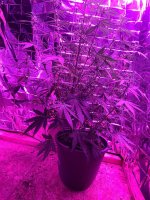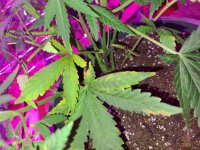Hey everybody!
Guess what day it is? That's right all you high schoolers itz edumacation day!
Today's topic was inspired by fellow member InTheShed, who made a point about Silica that he heard from another member. It caught my attention right away and although I was familiar with parts of the following topic there was lots I didn't know. So I've tried to summarize what I now know and what many of you may like to know too!
As a disclaimer, I don't endorse any of the items mentioned below. I don't see any
sponsors here that sell the product so I did post product names, but no links.
SILICON
What is silicon?
Silicon is a naturally occurring chemical element. Silicon is everywhere but is generally unavailable to plants. It readily bonds with oxygen and is rarely found in nature in its purest form. Silicon is typically seen as silicon dioxide or silica, better known as quartz, which is the most common component of sand. The silica component is what we’ll be discussing below.
What are the benefits of using silica?
Although silica is not essential for plant growth and development, it can provide many benefits. It has been found to improve drought tolerance and delay wilting in certain crops lacking irrigation. It guards against environmental stress, improves the uptake of water and minerals, and adds an extra level of protection against fungal diseases such as powdery mildew. Researchers found that powdery mildew was delayed in silicon treated zinnia, rose, sunflower, and cucumber, and phytophthora was delayed in gerbera. However, after 1-3 weeks both silicon treated and untreated plants had the same amount of disease.
Silicon appears to benefit certain plants when they are under stress, and it has also been found to help increase stem strength by strengthening cell walls. One study found when rice and wheat are silicon deficient their stems weaken and easily collapse in wind or rain, a condition called lodging. Another study on poinsettias treated with silicon had also shown reduced stem breakage.
How do plants uptake silicon?
In nature, microbes convert unavailable forms of silicon into silicic acid, also known as monosilicic acid(MSA). MSA is the only bioavailable form of silicon for plants, and the microbial process of converting it is slow and depends on many factors. In its most common forms silicon is not readily absorbed into biological tissues. Take potassium silicates as an example. Its molecules are too large to penetrate the plants cell walls. Microbes will have to convert it into silicic acid before the roots can take up the silicon. This process is called silicification, and it can take weeks or months before it occurs in any meaningful amount.
Silicic acid is therefore the most effective silicon additive since it is 100% bioavailable. But not all silicic acid is the same. In nature, silica exists in polymer form because it is stable. These are long chains of molecules, and in order for plants to use silicic acid it must be in monomer form, a single molecule which is monosilicic acid.
Soluble silica is also absorbed by plants. The ability of the plants to absorb silicon from soil, along with the amount of silicon that can be taken up by plants, depends on the concentration of silicic acid in the soil solution rather than the total silicon concentration of the soil.
What brand of silica should I be using?
Potassium silicate is a good soluble form of silica, but it is not compatible with many other fertilisers and must often be applied as a standalone. One way out of this limitation is to use a pre-formulated potassium silicate-based fertiliser which includes other synergists. I believe Pro-tekt would be a good example of this.
Although it’s listed as using potassium silicate, it appears to be soluble silicon. Below is a snippet from their PDF product data-sheet. I mention this product simply because more seem to use it over other brands.
DYNA-GRO'S unique Pro-TeKt® formula is an easy to use liquid concentrate that provides supplemental potassium (3.7%) and silicon (7.8%). Silicon is rapidly bound in leaf tissue and deposited in a non-translocatable form within 24 hours of uptake. Therefore a continuous source of soluble silicon is very important to combat pathogens. This can be from constant feeding in hydroponics or from retention in the growing medium. The surfactant characteristics of Pro-TeKt® result in better uptake of water and the minerals dissolved in it for better nutrition and growth.
Cost of 1L Pro-Tekt: $25.99 CAD
The brand I use is called Cyco Silica. It is a source of monosilicic acid, which as I mentioned is a 100% soluble source of silica. Did I know that before I bought it? No! I’m learning all this too and I just happened to get lucky. There were three brands on the shelf, and this was the prettiest one so it had to be the best.
Cost of 1L Cyco: $27.99 CAD
Conclusion
There are many benefits in adding silica to your plants diet. It’s the primary component in the formation of cell walls in plants, and it adds an extra level of protection against fungal diseases such as powdery mildew. It can also reduce heat stress by preventing plant transpiration, it builds strong stems, stalks, and thick leaves, it aids in the development of new vegetation and flowering, and it improves the uptake of water and minerals such as calcium.
In my opinion, unless a company doesn’t want to provide you the information, there is no need to spend high amounts of money for a product listed as having monosilicic acid over potassium silicate. It would appear that they know this already and they have ways around it, but if you look at the brands mentioned above I’d be buying the Cyco Silica. They claim they use monosilicic acid, and for $2.00 more there is no reason not to continue to use it.
Class dismissed, and please take your roaches with you.

 . That’s the same controller, it looks like. Would have to confirm with AC Infinity of course, because I might be wrong. It’s only a reckoning after all
. That’s the same controller, it looks like. Would have to confirm with AC Infinity of course, because I might be wrong. It’s only a reckoning after all 









 thanks
thanks
